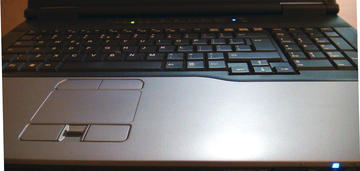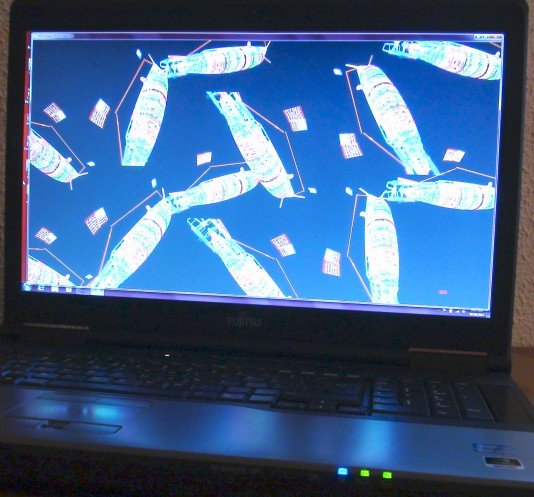The latest in Intel and Nvidia processors make this 17-inch mobile workstation a reliable workhorse.
By Tom Lansford
The German/Japanese workstation specialist Fujitsu has refreshed its 17-inch Celsius line with Nvidia Quadro Kepler GPUs and the Intel Ivy Bridge mobile platform to provide a more powerful generation of professional mobile computing in a quieter workstation.

When compared to last year’s H910 model, the Celsius H920 is almost the same on the outside yet brand-new on the inside. External appearances changed slightly with a new black keyboard replacing the H910s white keyboard, while the H920 keeps the separate number pad, spacious palm-rest area, 17.3-inch 1920×1080 display, and 32GB RAM memory. Inside the new Celsius H920 you’ll find the new Intel Core i7 CPU and Nvidia’s Kepler generation of professional Quadro GPUs—both of which improve the performance of this mobile workstation.
Workstations are designed to help the user solve specific problems. Engineering and design problems often require specific capabilities in a workstation, whether desktop or mobile. When it comes to mobility, engineers often need to make trade-offs. The Celsius H920 is designed to minimize the trade-offs and give the maximum power and capacity in a workstation that can travel. If your problems require a powerful CPU, then the Quad-core i7-3820QM, which I tested, or the faster 3920XM will meet your needs. If your problem requires top-of-the-line professional graphics, then the Nvidia Quadro K4000 is a great choice. If hard drive storage is an issue, then two internal, high-capacity hard drives will meet that need.

The design for the H920 is almost identical to the previous generation. I like the spacious palm rest area and the feeling of the keyboard. I do not personally use the full number pad in my work, but for many professionals it is indispensable. This is a nice feature which is often reserved for a 17-inch mobile workstation format. The 1920×1080 resolution for the display is basically “standard” for this class of workstation. The supported maximum resolution for an external display remains at 2560×1600 pixels.
The H920 weighs in at 4.25 kg which is unsurprisingly the same as the H910. The 210W power supply that you will need to lug around with this machine is just as large and heavy as the previous generation as well. Weight was never the strong point for this 17-inch line of Celsius, but instead one buys this workstation because of its performance, features, and capacity. As for mobility, Fujitsu did make one very significant mobility improvement and extended the battery life to a maximum of 9 hours. Three cheers to Fujitsu.

The ports and interfaces remained nearly unchanged, with one USB 3.0 and three USB 2.0 connections, VGA, DisplayPort, and Ethernet connections.
The unit comes with a host of pre-installed software, but realistically, there is nothing on the list that makes me excited. As for customers, either you or your IT department will manage the configuration. If it is the IT department, then you have no worries about pre-installed software, and if it is you, then do you really care if it has Norton Internet Security or Microsoft Office Starter pre-installed? For me it is just extra work to remove it before I install the virus protection and other tools I prefer. To be fair to the Fujitsu team, every workstation needs to ship with a basic assortment of software, and the Fujitsu team ticked the check boxes for virus protection, recovery, manageability, and basic productivity software.
A feature of great importance to every user is the three-year warranty. There is no doubt a machine of the power will be in active use for three or more years and as a mobile workstation, receiving more punishment than any desktop workstation. Please remember no warranty will protect your data if something goes wrong. The new user’s first task when setting up any new computer should always be putting a backup and restore system in place.
As already noted, the H920 provides a full keyboard with separate number pad. The keyboard has a solid feel to it, unlike last year’s model which I found a bit cramped. The review unit also came supplied with a Fujitsu mouse; it is a personal issue whether to use the build-in touch pad or an external mouse. I always try the touch pad but end up reverting to a mouse; to each his own.
There were a couple of items in the H910 which I did not like; one which remains with the H920 is the feel of the plastic housing for this machine. Even new out of the box, I have the feeling this machine feel more solid. When you pay a significant premium over the price of an office-class notebook computer, it should not only perform better but also give the user a sense of being substantial.
On the other hand, the Celsius H920 is much quieter than the H910. The older H910 that I reviewed was amazingly loud even just idling on the desk. With the new model, I never once noticed any exceptional noise. There are many different ways to improve the cooling and hence reduce the noise related to thermal control. For the H920, the notebook’s case is essentially the same as last year’s model, so the quieter design is clearly the result of other factors. It could be the components, although the power specifications for the Nvidia Quadro, for example, are much the same as last year’s model. Changes to the interior design and component placement could have been made to improve the cooling and, hence, the operational noise levels. However this was achieved, the quieter machine is appreciated.
GPU and CPU
Speaking of Nvidia Quadro, the H920 comes with the newest “Kepler” generation in the Nvidia Quadro mobile GPU; both the Quadro K3000 and the K4000 can be specified. (Fujitsu Product Manager Stefan Grotzke says that the unit can also be optionally configured with a Quadro K5000 for special projects.) The Quadro K4000 GPU produced faster results than the Quadro 5010M which I tested in last year’s model. The K4000 is manufactured using a 28nm process and has 960 graphics cores. In the end, the Quadro is critical for two important features. First, the Quadro is critical for the graphics performance which is indispensable for a graphics workstation, and it is also on the Quadro GPU from which most, if not all, of the ISV certifications depend. While important software vendors (ISVs) perform workstation-level certifications, the majority specifically certify the GPU and the driver.
The Intel Core i7 CPU is also critical to system performance. This 3rd generation Core architecture gives the H920 a 4-core, hyper-threading CPU with Turbo Boost Technology 2.0, and PCI Express Gen 3 support. In short, the multi-core, multi-threaded CPU gives the Celsius maximum performance for calculations typical in engineering simulations and high-quality rendering. Turbo Boost Technology 2.0 squeezes the most from the CPU when the application is not loading all the CPU cores with tasks by increasing the clock speeds of the active core(s) dynamically. And PCI Express Generation 3 doubles the speed of data transfers within the workstation architecture, namely between the main sub-systems of CPU, memory, and GPU. For these reasons, it is important that Fujitsu has added the latest technologies to the Celsius H920.
I appreciate support for two internal drives, capable of handling two solid-state (SSD) 512 GB drives for 1 TB of high-performance storage or two mechanical 1 TB hard drives for enormous storage capacity. Fujitsu’s Grotzke says customers can specify no RAID, RAID 0, or RAID 1 when ordering two hard drives; the factory will configure the workstation with two identical drives to assure RAID compatibility.
Testing performance
To test workstation performance, I prefer the Viewperf benchmark. This benchmark focuses on the graphics performance of the system using data representative of professional graphics applications. This is a primary concern of design and engineering professionals. The Viewperf benchmark is created and managed by specbench.org and is designed to provide performance-comparison data for graphics workstations.
The data sets are designed on industry applications for engineering, architecture, and visualization including Catia, SolidWorks, Allplan, Lightwave, Siemens NX, and Creo. In addition to using representative datasets, the benchmarks are the results of collaboration and peer-review within the industry. Therefore, comparative testing with Viewperf will provide good information on relative graphics performance for professional usage.
There is a short history and overview of the benchmark in an article called, “What is this thing called SPECviewperf?” The benchmark is free to download and use for any professional interested in evaluating the performance of graphics workstations.

For application specific evaluation, the SPECbench organization also has application-level benchmarks for several leading applications in different professional domains. These are called the SPECapc benchmarks.
The CADplace results for Viewperf on this Fujitsu H920 are:
| Viewset | Composite | Comments |
| catia-03 | 45.56 | The catia-03 viewset was created from traces of the graphics workload generated by the CATIA™ V5 R19 and CATIA V6 R2009 applications from Dassault Systèmes. |
| ensight-04 | 36.17 | The ensight-04 viewset represents engineering and scientific visualization workloads created from traces of CEI’s EnSight 8.2 application. |
| lightwave-01 | 49.09 | The lightwave-01 viewset was created from traces of the graphics workloads generated by the SPECapc for Lightwave 9.6 benchmark. |
| maya-03 | 53.11 | The maya-03 viewset was created from traces of the graphics workload generated by the SPECapc for Maya 2009 benchmark. |
| proe-05 | 15.7 | The proe-05 viewset was created from traces of the graphics workload generated by the Pro/ENGINEER Wildfire™ 5.0 application from PTC. Model sizes range from 7- to 13-million vertices. |
| sw-02 | 41.58 | The sw-03 viewset was created from traces of the graphics workload generated by the SolidWorks 2009 SP2 application from Dassault Systèmes. |
| tcvis-02 | 41.33 | The tcvis-02 viewset is based on traces of the Siemens Teamcenter Visualization Mockup application (also known as VisMockup) used for visual simulation. Models range from 10- to 22-million vertices and incorporate vertex arrays and fixed-function lighting. |
| snx-01 | 38.33 | The snx-01 viewset is based on traces of the Siemens NX 7 application. The traces represent very large models containing between 11- and 62-million vertices, which are rendered in modes available in Siemens NX 7. |
Our take
The Fujitsu Celsius H920 mobile workstation is a well-engineered workstation that should perform reliably. The Viewperf results are right where they should be for a computer equipped with the latest Intel and Nvidia processors. Fujitsu has a solid reputation for dependability and warranty support when needed. Our criticism of the perceived physical presence is admittedly too subjective to downgrade this from a “recommended” rating. After all, the latest generation of MacBook Pro is a very light computer, and it stands up quite well.
Contributing Writer Tom Lansford is Editor of CADplace.uk and CADplace.fr, where a longer version of this review originally appeared. GraphicSpeak and CADplace occasionally share articles.
Related
Review: Lenovo Thinkpad W530 makes mobile workstation no not an oxymoron





